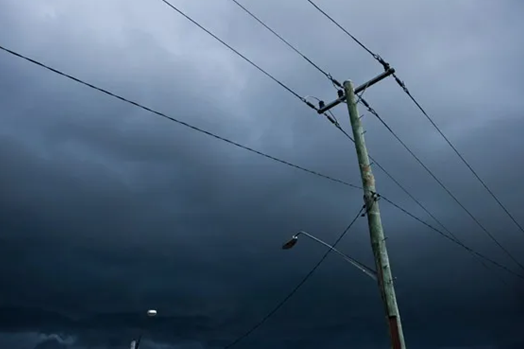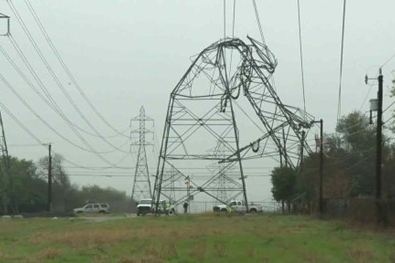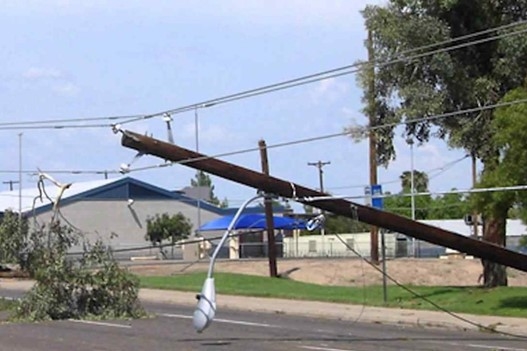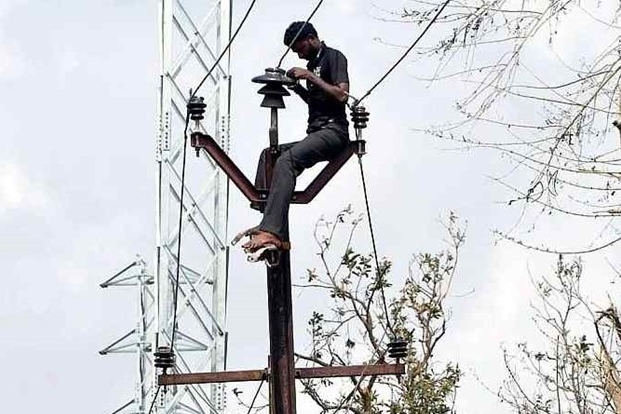A Power cut feel very frustrating and disrupt our daily lives, especially during storms, heavy rain, or strong winds. In places like the US, UK, and much of Europe, power failures happen less often because they have better infrastructure and smarter grid management.
In many developing countries, however, power cuts are much more common when the weather turns bad.
This article explains why bad weather causes power cut and suggests ways to make electricity supply more reliable where power cut or power outages occur frequently.
What is a power cut, Outage or Blackout?
A power cut or power outage is also known as blackout, power out, power failure, power loss, and even power draught.
When there is no power in a wider area, or a complete interruption in the supply of electricity it is called as power outage or blackout. Due to no power situation in that area no illumination or lighting available and hence at night it looks dark or black generally. That is why it is also called as power blackouts.

How many types of Power cut or Outages?
Power cut occurs when the supply of electricity is suddenly stopped. This happens in two scenarios.
First is intentional or scheduled power cut or outage such as power stopped to carry out maintenance of electrical power lines. Sometime to prevent harm to living beings such as humans and animals in hazardous situation power may be interrupted for safety reasons. This is defined as Planned Shutdown (PSD) or Emergency Shutdown (ESD).
In second scenario electric power is interrupted due to electrical fault on electric power line such as conductor snapping, insulator or equipment failure and many other technical reasons.
Most importantly, power interruption happens due to natural disasters such as cyclone, thunderstorm, earthquakes, rain and floods, wildfire, snow storm etc. These faults happen as in natural disasters, electric power lines and other electrical equipment and electrical infrastructures gets massively damaged.
These natural causes are beyond control of humans.
What is Power Staggering ?
In certain situation when electric power distribution company is not in position to supply all its consumers, they stagger the power supply. Such that at particular time or day power is supplied to one group or region of consumers and at other time it is supplied to other group of consumers. This is called as power staggering.
In India in certain states one day of week is followed as staggering day, and on this day power is not supplied in certain region or districts. Each district or regions have different staggering day.
How does Electricity Reaches from Power Plant to Your Home
Understanding how electricity reaches your home helps explain why weather can cause power cuts:
- Electricity Generation Electricity is created at power plants that run on thermal, hydro, nuclear, wind, or solar energy.
- Transmission High-voltage power lines carry electricity over long distances from power plants to substations.
- Distribution Electricity goes through transformers that lower the voltage, and then it travels along overhead or underground cables to our homes and businesses.
A major reason for weather related power failures is the use of overhead power lines. These lines face the weather directly. So it may can get damaged in storms.

Main Reasons for Weather Related Power Cut
Overhead power lines are popular because they are cheaper to install than underground cables. However, since they lie open to the weather, they face many risks during inclement weather.
Several studies have confirmed that severe weather increases the chances of power failures.
For example, a study in China found that strong winds and lightning strikes significantly raise the failure probability of these lines.
While research in Poland has linked ice storms and extreme ambient temperatures to a higher incidence of equipment breakdowns 2.
Below are the most common weather related causes of power failures for overhead power lines:

1. Lightning Strikes
Lightning often hits power lines or transmission towers. Even with safety systems in place, a strong lightning strike can damage equipment and cause widespread power cut.
2. High Winds
Strong winds shake the power lines, which may lead to short circuits. They also cause trees to fall onto the lines or damage poles and substations.

3. Falling Trees and Branches
Heavy rain and storms can make trees and branches fall on power lines. This often happens during storms and can cut off the flow of electricity in local areas.

4. Heavy Rain and Flooding
While rain alone rarely causes a power cut, flooding increases the risk. Floodwater can saturate the ground, weakening tree roots and causing trees to fall. It may also damage underground electrical systems.
5. ICE Storms and Snow
In cold areas, ice storms build up heavy layers of ice on power lines. The extra weight makes cables snap, and ice-laden branches may break and fall onto power lines.
History of major power cut or Outages resulting in to Blackouts
Despite all the efforts and technological breakthroughs, consumers has experienced some major power outages resulted in to blackouts. This has lead to economic downfall as well as rise in looting incidence.
April 28, 2025 – European countries
On April 28, 2025, major power outages occurred in several European countries, including Spain, Portugal, and parts of France and Monaco. This led to nationwide blackouts lasting more than 12 hours. Even after power was restored, train services and airports remained affected the following day.
Europe is considered one of the most advanced regions in technology, yet such an incident questions its image as a group of developed countries. The exact cause is still being investigated, but initial reports suggest a transmission line failure due to a wildfire. The economic impact and damages are still under assessment.
February 25, 2025 – Chile
Previously, On February 25, 2025, Chile experienced a nationwide blackout that impacted 14 of its 16 regions, leaving over 90% of the population without power for several hours. The blackout impacted basic services like the Santiago Metro, long-distance trains, and internet connectivity. It also impacted major copper mining operations like those of Codelco and Escondida.
The blackout occurred due to a failure in the electronic and software protection systems of one of 500 kV high voltage transmission lines, which led to a cascading failure of the national grid. In response, the government declared a state of emergency, imposed a night time curfew, and sent additional buses and security patrols to manage the crisis. Power was restored to the majority of areas the following day.
January 23, 2023 – Pakistan
On January 23, 2023, Pakistan witnessed a nationwide power blackout that plunged nearly 220 million people into darkness, with major cities like Islamabad, Karachi, Lahore, Peshawar, and Quetta being affected.
The blackout was triggered by a frequency surge in the national grid, resulting in high voltage fluctuations, and a cascading failure that split the northern and southern systems. The blackout disrupted essential services, including water supply, internet, hospital, and factory operations, with the textile industry alone suffering losses estimated at $70 million.
An investigation concluded the reason behind the incident, which is the failure to a technical fault that was exacerbated by an energy saving mechanism involving power generation shutdown during off peak usage.
October 4, 2022 – Bangladesh
On October 4, 2022, Bangladesh experienced an outage that affected nearly 75–80% of the country, including urban areas such as Dhaka, Chattogram, Sylhet, and Mymensingh.
The blackout lasted for 4-8 hours and resulted from a failure in the national grid due to a lack of coordination between power distribution companies, which were unable to reduce load according to directives from the National Load Dispatch Centre.
This blackout seriously impacted essential services like hospitals, telephone services, and the textile industry, which accounts for over 80% of Bangladesh’s export.
June 16, 2019 – Argentina, Uruguay, and parts of Paraguay
There was a mass blackout on 16 June 2019 in Argentina, Uruguay, and parts of Paraguay, impacting approximately 50 million people. The blackout started due to a procedural error by the Argentine transmission system operator imbalancing the system. This triggered a cascading failure of the grid.
The blackout cut off public transport, water supplies, and hospital treatment, and forced voters to cast ballots by candlelight in local elections.
August 17, 2020 – Sri Lanka
A nationwide power outage in Sri Lanka took place on August 17, 2020, when all of its population lost power for over seven hours. It resulted from a technical failure where the fault in the maintenance caused a cascading shutdown of the Norochcholai coal power plant, which produces the majority of the country’s power.
The blackout had an impact on day to day life, with Colombo traffic congestions due to faulty traffic lights, and interrupted water supply services. Economically, the blackout resulted in an estimated loss of nearly Rs 1 billion (approximately USD 5.4 million).
Why Are Power Cut & Outages More Common in Developing Countries?
Bad weather can cut power anywhere, but several factors make it worse in developing countries:
1. Overhead Power Lines in Crowded Areas
Power lines often cross densely populated areas. These lines face damage from construction work, trees and debris during storms, poor accessibility for maintenance crews.
2. Poor Infrastructure Investment and Maintenance
Many state run power companies (DISCOM) have low budgets. This means they often use old and weak power lines. They delay upgrading substations and transmission lines. Their poor maintenance increases the risk of failures.
3. Limited Manpower and Resources
In developing nations, power companies often do not have enough skilled workers to fix faults quickly. They also lack modern tools and systems to detect problems. Moreover, these companies usually do not have enough money to buy new equipment.
4. Aging Electrical Equipment and infrastructure
Aging transformers and power lines lose their strength during extreme weather. Replacing these systems costs a lot, which many countries cannot easily afford.
5. Lack of Automation & Smart Grid Technology
In many cases, power companies still depend on manual monitoring. They find it difficult to detect faults quickly, restore power from a distance, or stop small issues from growing into major failures.
The Heroic Work of Linemen in Power Restoration after Power Cut
Linemen work very hard to restore power after a storm. As per the demand of work they climb high poles and work in difficult, and dangerous conditions.
Linemen handle high voltage equipment even in extreme weather. Just imagine while coming out of bathroom, we sometimes hesitates while turning off switches if our hands are slightly wet or moist.
Lineman plays important role in power restoration. In many developing countries, linemen often work with inadequate safety gear and face high risks every day. Recognising their efforts and improving their training, pay, and working conditions is important.

How to Fix Frequent Power Cuts ?
Fixing frequent power cuts needs several improvements:
1. Improving in electrical distribution network
Frequent power cuts can be addressed by improving infrastructure in several ways.
First, replacing old power lines with weather resistant cables helps prevent cuts caused by storms or extreme conditions. These modern cables are stronger and less likely to break.
Second, upgrading outdated transformers and substations ensures the system can handle electricity demands more reliably. Old equipment often fails under stress, causing blackouts.
Finally, burying power lines underground in high risk areas, like those prone to hurricanes or flooding, protects them from damage. While this is expensive, it reduces disruptions in vulnerable regions.
Each step strengthens the power grid, making cuts less common.
2. Improved Maintenance Practices
Regularly checking power lines and equipment will help in identifying aging components, before they fail. This may prevent sudden power cuts.
Regular tree trimming will prevent tree branches falling on power lines during storms. This is a most common reason during power outage, blackouts.
Also, if they make a plan for what to do before a storm even arrives, the workers can get to fixing the electricity super fast. Because they already have their tools ready and know exactly what to do.
Doing this makes the whole power system stronger and means fewer times your lights will go out.
3. Enhanced Training & Resources for Linemen
Improving training and resources for linemen is important. When you give better safety equipment and protective gear, Linemen can work efficiently and safely in tough conditions.
To reduce delay in power restauration enough number of skilled technicians should be there. Using improved communication tools or tracking technology such as FPI, helps linemen locate and fix faults quickly.
A Fault Passage Indicator (FPI) is a fault indicating and locating device. Power grids use a Fault Passage Indicator (FPI) to detect and indicate the presence and location of faults, such as short circuits, ground faults, or load interruptions
These steps make the repair process smoother and more effective, keeping the power on for longer.
4. Smart Grid Technology
A smart grid is a modern electricity network that uses digital technology and two way communication to deliver power more efficiently, reliably, and sustainably.
It works by constantly monitoring and managing electricity from producers to consumers, using smart meters, sensors, and automated controls to adjust supply based on demand in real time.
By installing automatic fault detection systems, you can monitors electrical power line in real time. We can minimize power outages by using remote controlled switches.
5. Public Awareness & Community Involvement
To help reduce frequent power cuts, educating customers and ordinary citizens and involving the community is necessary.
Teaching people to report damaged power lines before storms enables quicker repairs, preventing outages. Informing them about avoiding illegal power connections, which can overload and destabilize the grid, ensures a stronger system.
Encouraging reduced energy waste, like turning off unused appliances, prevents overloading the grid during peak times. When communities understand and act on these steps, they support a more reliable power supply and contribute to fewer disruptions.
Conclusion
Power cuts in bad weather happen for many reasons. Instead of blaming power companies or workers, we can work together to fix the problem. Developing countries can make power more reliable by upgrading equipment, like using stronger lines and cables, training workers better, and using smart technology to find issues fast.
These changes take time and need support from people and the government. Reliable power systems help businesses to grow and create jobs. This help schools and hospitals stay open. With all of this everyday life get better with steady electricity power supply.

1 thought on “Why Do Power Cut and Outages Happen During Bad Weather?”